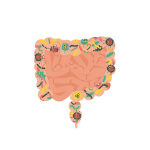Selective Eating: If Food Is Medicine, What Can We Do for Picky Kids?
Docere
Teresa Neff, ND, CLE
As naturopathic physicians, we enthusiastically encourage our patients to eat a varied diet that nourishes their bodies. Adult patients who struggle to eat healthfully can generally reason themselves into making acceptable food choices. Kids, however, do not reason. If we are what we eat, how do we establish optimal health foundations among our youngest patients?
A Close-up Look at Picky Eating
Every child goes through a phase of picky eating, usually from about 2 to 4 years of age. A normally developing child will suddenly eschew a few foods he used to eat, but will maintain reasonable variety without argument. Keep this in mind: toddler nutrition occurs over the course of a week. In other words, toddlers do not need protein, greens, and super-foods at every meal, or even every day. So, a child who will eat various proteins, vegetables, fruits, and grains, albeit unpredictably, is developing typically.
A true picky eater rejects most foods, and may begin to do so even before 2 years of age. Parents who have to bribe the child to come to the table, and bribe them again to stay long enough to eat 4 bites, are parenting a picky eater. Kids who will only eat apple sauce, peanut-butter sandwiches, and sliced-up hot dogs, are picky eaters. In other words, true picky eaters would rather skip the meal altogether or will eat only a small number of foods.
A New DSM Diagnosis
A relatively new diagnosis – Avoidant/Restrictive Food Intake Disorder (ARFID) – was added to the DSM-5 in May of 2013. Although it can be summarized as extremely selective eating, ARFID is defined as the avoidance or restriction of food for a reason other than wanting to control weight or address concerns with body image; it is distinct from anorexia nervosa and bulimia nervosa.1 The food restrictions must also not be attributable to cultural or religious practices, or food scarcity. In ARFID, the dietary restrictions lead to weight loss, failure to gain weight, nutritional deficiency, impaired psychosocial functioning, or reliance on nutritional supplements or enteral feeding to achieve appropriate caloric intake.1 If the disordered eating can be explained by another diagnosis (whether medical or mental health), it is not considered ARFID. However, if the eating pattern is more extreme than would be expected with that particular other diagnosis, ARFID may still be diagnosed.
Prevention Is the Best Medicine
A child’s best chance to avoid selective eating is to grow up in a culture of healthy food relationships. I have the privilege of speaking to baby groups about solid food introduction. I spend ample time going over the idea of growing healthy eaters. I joke with them sometimes that babies will learn to eat despite what they do. But in all seriousness, some parents make fairly grave mistakes in the process, and I am grateful for any chance to prevent those.
Since fetuses and nursing babies can detect the smell and taste of what mom has eaten, healthy food culture begins in the womb and continues with breastfeeding. Long before solid food introduction, baby should sit at the table for regular meal times and watch parents in the kitchen; bonus points are deserved for involving baby in food preparation by offering smells and explaining what is occurring in the kitchen. Baby should participate in grocery shopping; holding produce, sniffing spices, hearing the names of foods – all of these help introduce kids to the world of food. Bonus activities are shopping at farmer’s markets, going to u-pick farms, and participating in vegetable gardening.
Introducing Solids Without Creating a Picky Eater
When baby is ready for solids, there are some key logistics to consider.
Timing is important. To help decrease the risk of food allergies, solid foods should be introduced around 6 months of age (possibly sooner), when the baby is ready. Keep in mind that the first taste of food can really be just that – a taste – a lick off a parent’s finger just to introduce the idea of food. Signs that baby is ready for food include good motor control of the head while sitting, extreme interest in watching people eat, and increased appetite. Counsel the parents to watch for the cues, but dispel any apprehension they may have about the process. Ensure they do not wait too long; the time to introduce new textures and tastes is early, and babies are generally ready to start tasting by about 6 months.
The amount of anxiety I have seen regarding food introduction is remarkable. Babies notice our distress, and when it centers on food, odds are high that baby will adopt the same emotion. Food must be presented to baby in a “take it or leave it” fashion, with zero attachment to whether that food gets swallowed, spit out, or completely ignored.
One of the easiest ways to ensure baby is shielded from parental anxiety is to use Baby Led Weaning (BLW). In BLW, baby gets a large chunk of soft food to gnaw on. The website (BabyLedWeaning.com), book, and video all explain the details. I like it because it puts all the control in baby’s hands. Parents can sit back and eat their own meals without fussing over spoon-feeding. Spoon-feeding purees can be done, and in some instances must be done. However, the clinician teaching a parent how to spoon-feed must emphasize the importance of satiety cues. The moment baby turns away, spits the food out, fails to turn toward the spoon, or pushes the spoon away, that meal is over. With either method, parents must allow baby to make a mess, and refrain from cleaning it up until the end of the meal. Wiping up the mess after every bite sends the message that messes are not allowed and that baby is therefore doing it wrong. Furthermore, children learn by making a mess; notice how they draw, build, and play – as with eating, they make a mess.
I discourage my patients from doing the airplane spoon, from begging the child to take just one more bite, and from bribing kids to eat. All of these promote the idea that the parent knows better than the baby about satiety. (Furthermore, have you ever enjoyed having someone shove a spoonful of food in your face?) Babies learn by taking control, and with so few arenas in their lives that they can control, giving them the reins over their food sends a clear message: there is no power struggle here.
Is Picky Eating the Tip of the Iceberg?
The research into selective eating is limited. In my clinical experience and in the research that is available, selective eating is often found in conjunction with psychological disorders such as anxiety, depression, sensory processing disorder, autism, and ADHD. The picky eating is likely a manifestation of the underlying disorder, and I believe it is worth our time to diagnose that disorder.
A study published in Pediatrics concluded that moderate-to-severe selective eating patterns are associated with concurrent and prospective psychological symptoms such as depression, anxiety, and ADHD.2 The investigators claimed that as eating grew increasingly limited, psychological symptoms increased. The authors concluded that clinicians should intervene (seek and treat the underlying diagnosis) for even a moderately selective eater. A commentary on this study pointed out flaws with the methods used as well as the interpretation of the data, and questioned the conclusion that clinicians must address potential psychological concerns in any moderately picky eater.3 The implication was that it could be a waste of everyone’s time and energy to pursue underlying pathology and treatment in every moderate-to-severe selective eater we encounter. The commentator suggested further study.
I am of the opposite opinion. As naturopathic physicians we are trained to seek and treat the cause. Solid research would be ideal, but in its absence, the onus is on us to investigate each case of picky eating fully. Considering the links between the brain and gut, an association between picky eating and underlying pathologies makes sense.
Also consider an underlying medical diagnosis. The possibilities are numerous, and certainly would be narrowed down by the presence of other symptoms. Gastrointestinal disease, such as gastroesophageal reflux, cyclic vomiting syndrome, and abdominal pain (whether functional or otherwise), food allergies, and food sensitivities are all important conditions to be ruled out. In other words, food may either literally be causing pain, or the child may perceive that as the case.
A Multipronged Approach
As always, find the cause. Is the child picky with his eating because he is engaging anxious and controlling parents in a power struggle? Or is the child picky because he has an undiagnosed problem? Hint: it may be both.
For the families that are battling for control, treat the parental anxiety and need for control. Teach them that it is developmentally appropriate for children to seek control, that they learn by doing so. Point out that very few opportunities exist for a child to establish control. Explain that if food becomes an arena for power struggle, it will remain so, and the child will win, always, simply because you cannot force food down the throat. Teach them to offer food without emotional attachment and to refrain from cleaning any food mess until the meal is over. For spoon-fed babies, instruct them to pay careful attention to the baby’s cues, and to end the meal as soon as the baby loses interest.
Coach them to backtrack away from allowing pickiness. Meals should be eaten at routine times, as a family, around the table, and with no distractions (such as screens). Snacks should also be eaten at routine times; no grazing allowed. Forestall guilt by acknowledging to your parents that most families will not eat every single meal, or even every single dinner, in this manner, due to busy schedules. Parents are not to make special meals for kids. There is 1 meal, and it should be served family-style. Kids get to choose what to eat and how much. This arrangement gives both parent and child an appropriate dose of control. At around 2.5 years of age, kids may start learning to serve themselves. Each meal should include 1 or 2 foods that you know the picky kid likes. The child can either bypass the rest of the meal or try it without pressure. Some people advise that the child be required to try 1 bite of everything new. I generally do not agree. I think when you are trying to back a family away from power struggles, this practice can send a convoluted message. However, there are kids who respond well to this practice. Parents are not to bribe children to eat. Make the meal fun by engaging in conversation. In addition to talking about how everyone’s day went, use guided talking points. Some families use conversation-prompting cards. Others just hit certain points every time, such as what is everyone grateful for. The key is that the parents are making eating fun, while taking the focus off of the food. Give it time; it will not be an immediate turnaround.
Tread lightly in teaching these interventions to families with children on the spectrum or with sensory processing disorder. These children may respond paradoxically to the tactics listed above. For instance, social interaction for children on the spectrum can be extremely stressful and therefore not conducive to eating well. You and the family may need to think outside the box; listening to the radio or reading books at the table, while atypical, may enhance the child’s ability to eat. Furthermore, these kids may have such a strong aversion to certain smells, or the presence of certain foods, that they may not be able to participate in certain family meals.
For the children who may have an underlying diagnosis, find it and treat as you see fit. Many children, especially those with sensory processing problems, gagging, vomiting, and food phobias, will benefit from occupational therapy, and possibly from physical therapy or speech therapy.
Abigail Natenshon, MA, LCSW, GCFP, is a psychotherapist specializing in children and young adults, and an expert on eating disorders. She advocates the use of Feldenkrais and Anat Baniel methods, since this process involves brain retraining. She claims these 2 methods have been “particularly successful in reorganizing and creating new neurological pathways in young and newly forming brains.”4
In cases of ARFID, an integrative team, likely at an eating disorders clinic, will be required. The acute priority is to achieve medical stability by re-feeding, and these cases may be initially managed in the hospital. A nutritionist should ensure adequate caloric intake. Occupational and physical therapists, and other therapists, as appropriate, should lead behavior modifications. Cognitive behavioral therapy can help patients reformulate underlying thought patterns.5 The underlying anxiety must be addressed.6 Family therapy may be helpful.6 The role of antidepressants and anxiolytics is unclear. The naturopathic doctor should ensure that any comorbid conditions have been diagnosed and are being treated, and should incorporate additional alternative therapies as deemed appropriate, including nutrient repletion.
What About Sneaking in Foods/Nutrients?
There are myriad ways of sneaking more nutritious foods into tastier foods. Broccoli and spinach can be ground into spaghetti sauce, roasted cauliflower can be smothered in cheesy sauce, and fish oil can be sneaked into a smoothie. I do not generally advocate that parents try these sneaks. I would much rather they achieve a food culture that empowers kids to like most foods, so that sneaking is not necessary. Furthermore, extremely picky eaters will sniff these sneaks out and refuse to eat them. Then you wind up with a frustrated parent and a kid who is now mistrustful of the sneaky parent and even more put off by food in general.
What is the Role of Supplements?
Since picky eaters do not get adequate nutrition from diet, supplements – particularly multivitamins and omega 3s – can be an important contribution. The difficulty is that a picky eater is highly unlikely to accept supplements. Some kids will accept gummy vitamins and omegas. You’ll need to assess the need for these and weigh that against the quality of the supplement they are willing to eat and the quantity needed. In general, it is important to avoid sending the message that nutrition comes from what is essentially a candy.
References:
- American Psychiatric Association. Diagnostic and Statistical Manual of Mental Disorders. 5th ed. Arlington, VA: American Psychiatric Publishing; 2013.
- Zucker N, Copeland W, Franz L, et al. Psychological and Psychosocial Impairment in Preschoolers with Selective Eating. Pediatrics. 2015;136(3):e582-e590.
- Huh SY, Sullivan NR, Huntington N. Psychological and Psychosocial Impairment in Preschoolers with Selective Eating: Concerns Regarding Methods and Data Interpretation. 2016;137(1). doi: 10.1542/peds.2015-3635A. Epub 2015 Dec 31.
- Natenshon A. Understanding Picky Eating. Available at: https://treatingeatingdisorders.com/understandingpickyeating.aspx. Accessed April 14, 2018.
- Bryant-Waugh R. Avoidant restrictive food intake disorder; an illustrative case example. Int J Eat Disord. 2013;46(5):420-423.
- Norris ML, Spettigue WJ, Katzman DK. Update on eating disorders: current perspectives on avoidant/restrictive food intake disorder in children and youth. Neuropsychiatr Dis Treat. 2016;12:213-218.
Image Copyright: <a href=’https://www.123rf.com/profile_markez123′>markez123 / 123RF Stock Photo</a>
 Teresa Neff, ND, CLE, specializes in pediatric and adolescent primary-care medicine at the Seattle Nature Cure Clinic in Seattle, WA. Dr Teresa employs a wide range of tools, including craniosacral therapy, visceral manipulation, and constitutional homeopathy. She holds a certificate from the Simkin Center as a Certified Lactation Educator. She volunteers with PEPS, offering instruction in introducing solid foods to babies. She blogs for NaturopathicPediatrics.com and for DrTeresaNeff.blogspot.com. Dr Teresa graduated from Bastyr University and trained for 2 years at The Kids Clinic before entering private practice. She lives with her husband and two sons, all excellent eaters.
Teresa Neff, ND, CLE, specializes in pediatric and adolescent primary-care medicine at the Seattle Nature Cure Clinic in Seattle, WA. Dr Teresa employs a wide range of tools, including craniosacral therapy, visceral manipulation, and constitutional homeopathy. She holds a certificate from the Simkin Center as a Certified Lactation Educator. She volunteers with PEPS, offering instruction in introducing solid foods to babies. She blogs for NaturopathicPediatrics.com and for DrTeresaNeff.blogspot.com. Dr Teresa graduated from Bastyr University and trained for 2 years at The Kids Clinic before entering private practice. She lives with her husband and two sons, all excellent eaters.










